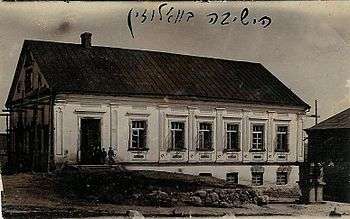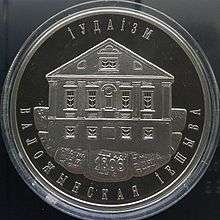Volozhin Yeshiva
Yeshivas Etz Chaim Yeshiva-Volozhin commonly called the Volozhin Yeshiva, was a prestigious Lithuanian yeshiva (talmudical college) located in the town of Volozhin, Russia, (now Valozhyn, Belarus). It was founded by Rabbi Chaim Volozhiner, a student of the famed Vilna Gaon, and trained several generations of scholars, rabbis, and leaders. Completed in 1806, it was the first modern yeshiva to be established and became known as the "mother of all yeshivas," serving as a model for all later yeshivas which opened in Lithuania.[1]

The institution reached its zenith under the leadership of Rabbi Naftali Zvi Yehuda Berlin, who became the rosh yeshiva (dean) in 1854.[1] In 1892, demands of the Russian authorities to increase secular studies forced the yeshiva to close. It reopened on a smaller scale in 1899 and functioned until 1939 when World War II broke out. During the war German soldiers used the building as a stable and it was subsequently converted into a canteen and deli.[2] The site was returned to the Jewish community of Belarus in 1989.[2] The building is considered a cultural and architectural landmark[2] and in 1998, the Volozhin Yeshiva was registered on the State List of Historical and Cultural Monuments of the Republic of Belarus.[3]
History

The yeshiva was founded in 1803 by Rabbi Chaim Volozhiner. After his death in 1821, he was succeeded as head of the yeshiva by his son, Isaac. When Isaac died in 1849, Rabbi Eliezer Fried was appointed head of the yeshiva, with Rabbi Naftali Zvi Yehuda Berlin as his assistant.[4]
Rabbi Fried died soon after, in 1854, whereupon Rabbi Berlin became the new head along with Rabbi Yosef Dov Soloveitchik, Reb Chaim Volozhiner's great-grandson who was the assistant rosh yeshiva.[4][5] In 1865, Soloveichik left to become a rabbi in Slutsk.
From 1886 through 1991, alumni of this yeshiva and their descendants ran a synagogue on the Lower East Side of Manhattan, New York that carried the name of this yeshiva.[6][7]
The Volozhin yeshiva closed in 1892. The reason for the closure was the Russian government's demand for a dramatic increase in the amount of time spent teaching certain secular studies.[4] The pressure from the Russian government came from the Maskalim accusing the yeshiva of being subversive.[5] It is to note that it is documented in the biography of R. Chaim Soleveitchik that there were secular studies taught for a short period some nights that were barely attended. However these were concessions legally mandated that the rosh hayeshivas felt were necessary rather than shut down the yeshiva. When the government imposed extreme guidelines Rabbi Berlin refused to comply and allowed the government to close the yeshiva. : "All teachers of all subjects must have college diplomas ... no Judaic subjects may be taught between 9 AM and 3 PM ... no night classes are allowed ... total hours of study per day may not exceed ten."
Others, such as historian Shaul Stampfer, say the root of the problem was Rabbi Berlin's attempt to install his son as Rosh Yeshiva in the face of opposition. Russian government documents that have recently come to light seem to indicate that this was a consideration in the yeshiva's closure.[8]
Rabbi Refael Shapiro, the son-in-law of Rabbi Naftali Zvi Yehuda Berlin, reopened the yeshiva in 1899, albeit on a smaller scale. It remained open until World War II, and was reestablished, also on a small scale, in Israel after the war.
Threat of repossession
In 2000, the Valozhyn authorities returned the building to the Jewish Religious Union of Belarus, an Orthodox Jewish umbrella organization. In 2007, the government of Belarus threatened to repossess the building unless the community raised $20,000 in order to renovate it. The Jewish community in America took action and Agudath Israel raised money to restore the site.[9] The yeshiva building is presently undergoing restoration through the partnership of Yad Yisroel and the Union of Religious Congregations of the Republic of Belarus.[10]
- Volozhin yeshiva


 Tempera, Anatoly Nalivaev, 1964
Tempera, Anatoly Nalivaev, 1964 Tempera, Anatoly Nalivaev, 1967
Tempera, Anatoly Nalivaev, 1967
Prominent alumni
|
References
- William B. Helmreich (February 2000). The world of the yeshiva: an intimate portrait of Orthodox Jewry. KTAV Publishing House, Inc. pp. 6–8. ISBN 978-0-88125-641-3. Retrieved 21 September 2011.
- World Monuments Fund: Volozhin Yeshiva.
- Jews of Belarus Move to Save Their Past, East European Jewish Heritage Project.
- Wolkenfeld, David. "Rabbi Hayyim Soloveitchik of Brisk". www.sefaria.org. Retrieved 2020-08-10.
- Schloss, Chaim (2002). 2000 Years of Jewish History: From the Destruction of the Second Bais Hamikdash Until the Twentieth Century. Feldheim Publishers. ISBN 978-1-58330-214-9.
- Kadinsky, Sergey "Rutgers Bathhouse, Lower East Side" Forgotten-NY March 29, 2018 http://forgotten-ny.com/2018/03/rutgers-bathhouse-lower-east-side/
- Jablons, Abraham "Volozhiners in America" JewishGen, Inc. https://www.jewishgen.org/yizkor/volozhin/vol669.html
- See The Dinur Center for Research in Jewish History: Shaul Stampfer
- "Old building of Volozhiner Yeshiva to be confiscated". May 3, 2007. Retrieved 2007-06-26.
- http://www.yeshivavolozhin.org/about-us/
Bibliography
- Shaul Stampfer, Lithuanian Yeshivas of the Nineteenth Century
- E. Leoni, Wolozyn; sefer shel ha-ir-shel yeshivat “Ets Hayim” Tel-Aviv, 1970
External links
| Wikimedia Commons has media related to Valozhyn yeshiva. |
- Student Portraits
- Partial Translation of Wolozyn; sefer shel ha-ir-shel yeshivat “Ets Hayim”
- The Volozhyn Genealogy Chain
- Photo of Volozhin yeshiva on site “Globe of Belarus” (in Russian)
- City Portal of Volozhin
- Yad Yisroel Yeshiva Volozhin Renovation
- Volozhin Yeshiva in the Bezalel Narkiss Index of Jewish Art, Center for Jewish Art, Hebrew University of Jerusalem